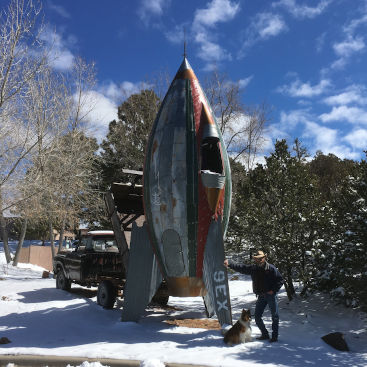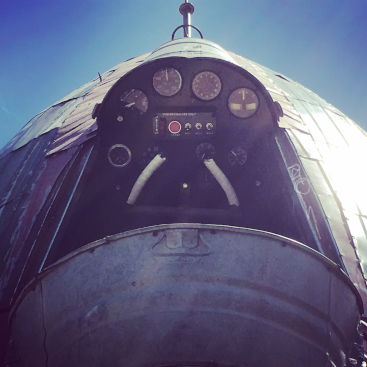Open-cockpit Rocket Sculpture, Santa Fe NM
Niner Echo Xray was purchased in 2018 by the Santa Fe Institute’s Miller Omega Program. It is installed at SFI’s Cowan campus.Imagine that you found Flash Gordon’s rocket in an arroyo and cleaned it up a little. I’ve wanted to build a rocket since . . . well, since forever. I built a hang glider and learned to fly it when I was 15 without ever having seen one in person. The incredible rush of foot-launching a hang glider made of surplus aluminum with black plastic duct-taped on is pretty close to what you might get from your own personal rocket. –Bob Davis

The Vision
This open-cockpit rocket sculpture harkens back to the years immediately following World War II when just about everything seemed possible, children’s books were full of crazy crap like Mom and the kids running around on the Moon in space suits, and guys were building airplanes and gyrocopters from plans in the garage.
Retrofuturism
The years following WWII was a time when anything seemed possible and a solution was at hand for nearly every problem faced by mankind. 1960 was the watershed year: solid state electronics had been invented, and sending men into space was a real deal. Guys were building dragsters, kit airplanes, and gyrocopters in the garage on weekends. Were personal rockets far off? The Do-It-Yourselfer was then and is now enhanced and enabled by affordable light trucks known as pickup trucks. Drive it to work, pick up materials for the new garage on the way home. Freedom to pick out your own lumber, take your trash to the dump, cut your own firewood, and, why not?, take your rocket out to the pad.
How to describe the sense of possibility — of what seemed within the realm of possibility — in the late 1950s and early 1960s? Let’s try to stand in the shoes of a couple people I have known.
My father’s father, Chester Thomas Caverly Davis, was born in 1894 right at the cusp of the automobile taking the place of the horse and carriage. He fought in the First World War, raised a family in through the Depression, saw his sons and their pals go off to fight WWII. He lived to ride in a jetliner, and watch a man walk on the moon. He saw smallpox, measles, and polio get smacked down by science. He died in 1984 just as computers were becoming powerful machines. Dee, as he was known to his grandkids, had a real sense of wonder about the modern world and was confident that solutions could be found for just about anything. Can you see why he may have felt this way?
Dick Hicks, our next door neighbor when I was a boy, grew up poor during the Depression in Kansas City. Told me he had to save food on his plate at dinner for his dog to have something to eat. As a teen he worked as a fireman on one of the last steam trains in the USA shoveling coal into a glowing firebox all night, and tried to give me a sense of the art to which the engineers aspired in moaning the steam whistle at crossings. Dick was a diesel mechanic on a submarine during the war. He was a powerplant operator in town and then went to work as a technician on an experimental fusion reactor. He rode around on an old BSA motorcycle and was a pilot who belonged to a flying club that had a Cessna. Dick built a gyrocopter in his back yard. He taught me to fly the Cessna on instruments when I couldn’t see over the dash. I don’t know if Dick graduated from high school or not, but he was a cool guy with a great can-do attitude. He made a nice life for himself and his family. We can see some of his reasons for being optimistic.

Mechanics
The open-cockpit rocket is constructed of three welded steel longitudinal trusses, circular ribs, with old galvanized sheet metal and corrugated roofing on the outside. The egg shape makes it a strong structure without elaborate interior support needed, and this keeps the weight down. The cockpit contains used light aircraft instruments. The shiny nose cone is stainless steel.
The 1966 Ford has a well-earned patina. It’s a 3/4 ton, four wheel drive, straight six workhorse. The cab, front clip, and hood are not original to the truck frame, and I built the dump bed in ’85 or ’86. The dump bed provides the lift action to put the rocket into launch position. This truck was my main vehicle for hauling stuff from 1980 until I mounted the rocket on it. It can easily haul a 4500 pound load, so the rocket, which weighs less than a thousand pounds is an easy load, and you can’t really tell when driving it that the rocket is back there except for the looks you get.
Visit the Niner Echo Xray Photo Gallery